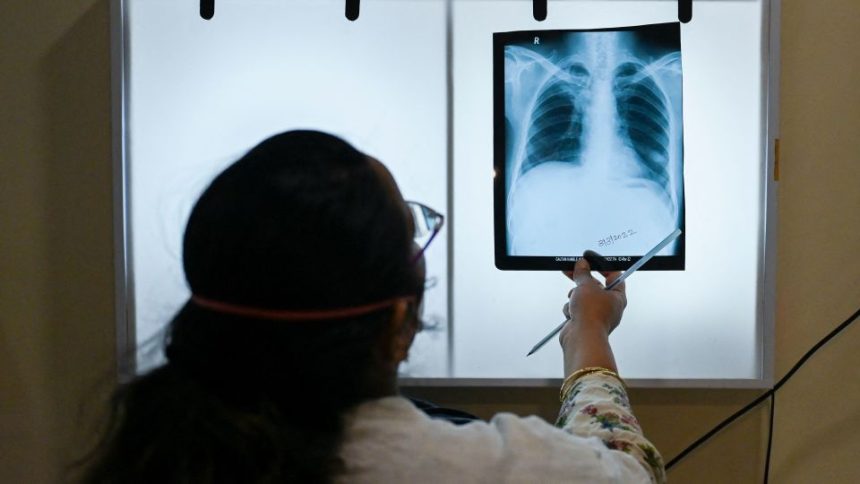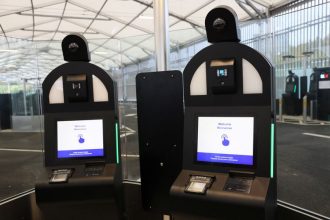Relentless coughing echoes through the Mumbai suburb of Govandi, where families live cramped under tarpaulin and salvaged wood. The narrow lanes are waterlogged and airless, and here in India’s financial capital, a deadly disease is lurking at every door.
Doctors on the ground estimate that tuberculosis has infiltrated almost every second home of this eastern urban compound, killing residents and robbing many families of their livelihoods.
The local crisis is a microcosm of a national health care crisis. India is home to 27% of the world’s TB cases and records an average of two deaths related to the infectious disease every three minutes, according to the World Health Organization (WHO).
The government has pledged to eliminate the disease by the end of this year – but experts say that goal is dangerously out of reach – with health care system gaps and socioeconomic barriers stalling efforts.
Mehboob Sheikh was diagnosed with TB six months ago – more than a decade after his wife died of the disease. For him, the realities of living with it are far too real.
Mehboob Salim Sheikh, 40, battles tuberculosis in Mumbai after losing his wife to the same disease a decade earlier. – Ayushi Shah/CNN
“I have lost a lot of weight, I can barely walk now, and I get breathless if I speak more,” he told CNN, his gaunt face and hollow eyes symptoms of his plight.
The disease has already cost him his job at a printing press – the relentless fatigue and weakness left him unable to cope with the long shifts on his feet. Sheikh has been on an extended nine-month course of antibiotics, but with just three months of that treatment left, his body is still frail. Any sign of a recovery is hard to see.
His children – malnourished, vulnerable and too young to understand – hover around while he coughs.
Once earning 15,000 rupees ($171) a month, he now struggles to pay their school fees.
“If my body holds on, I will keep living. If not… that’s the end.”
A national crisis
In 2018, Prime Minister Narendra Modi stunned global health circles by pledging to eliminate TB by 2025 – five years ahead of the WHO’s global target. Elimination means cutting new TB cases by 80% and deaths by 90% compared with 2015 levels.
Experts viewed the government’s 2025 target as a monumental challenge, and just months ahead of the deadline, TB remains one of India’s most stubborn public health crises.
India’s struggle with the disease, experts say, is fueled by a potent combination of biology, poverty and systemic health care gaps.
“We are a high-burden nation,” said Dr. Lancelot Pinto, an expert in lungs and the respiratory system, in Mumbai. “We do not necessarily have all the resources in place to scale up and eliminate TB by 2025.”
The bacteria that causes the disease, Mycobacterium tuberculosis, has haunted humanity for millennia, with traces found in Egyptian mummies. It can remain dormant inside the body for years and develop resistance to drugs, making it difficult to eradicate.
The disease thrives in India’s densely populated, impoverished pockets, where people have little access to consistent medical care.
After 10 years working in Govandi, health worker Pramila Pramod says the number of TB patients she sees every month has remained the same.
The suburb’s alleys create the perfect transmission pathway, with no cross-ventilation, open drains clogged with garbage, and families of six huddled in single rooms. Fear of social stigma means some patients hide diagnoses from neighbors, schools, even spouses.

Local doctors in Govandi say that TB has infiltrated “almost every second home” in the neighbourhood in Govandi, Mumbai on July 28, 2025. – Ayushi Shah/CNN
“Sometimes there is a young girl of marriage age. (Her) parents won’t tell anyone she has TB,” said Pramod, who volunteers at Alert India, a non-governmental organization that works with people affected by infectious diseases. “How will they find a boy for her otherwise?” she recalls them asking.
This vulnerability is exacerbated by a struggling health care system where the public sector is plagued by decades of underinvestment, staff shortages and outdated facilities. The country’s vast but unregulated private sector, while providing essential and crucial services, can be costly to access.
India’s diagnostic strategy is another major hurdle. Nearly three-quarters of diagnoses still depend on sputum microscopy, a method first introduced around 140 years ago, that can miss active cases. The more modern molecular tests – which accurately detect the bacteria’s DNA – are used in a little over 1 in 4 diagnoses, according to Pinto.
This gap means countless infections go untreated and dangerous, drug-resistant strains spread undetected. “So, unless we detect and treat proactively – not just wait for symptoms – we’ll continue to miss cases,” Pinto said.
The government’s promise
Chest aches, fevers, debilitating headaches and chills pained 15-year-old Sufiya Syed for more than a year before doctors finally diagnosed her two months ago.
As TB took over her body, her weight dropped from 88 pounds to 55 pounds (40 kilograms to 25 kilograms). During that time, she still went to school. Now, she says she can’t focus on her studies, with nausea and sleepless nights leaving her body struggling to battle the disease.
“Every day when I wake up, I feel like I am going faint and completely black out,” she said. “Sometimes I don’t have food for four or five days. My mom forces me to eat.”

Months of undiagnosed TB has left 15 year old Sofiya Syed left her battling nausea, sleepless nights and constant fatigue. – Ayushi Shah/CNN
The government has ramped up efforts by offering free TB testing and medicines through public health facilities, aiming to ensure early diagnosis and treatment, reaching even the most vulnerable populations.
Some progress has been made.
India has reduced cases by 17.7% since 2015, nearly double the global average decline, and deaths have dropped from 28 to 22 per 100,000 people, according to data from India’s Ministry of Health and Family Welfare.
But with just months to go until the government’s end-of-2025 deadline, its promise is unraveling.
Major challenges, including a shortage of staff to maintain comprehensive treatment, vulnerability in mapping in high-risk areas and poor health-seeking behavior, have allowed the disease to persist, according to a 2023 parliamentary report on the government’s eradication push.
The Covid-19 pandemic worsened matters. Lockdowns halted screenings, disrupted medicine supplies and diverted health workers, the report said.
CNN has contacted the Indian government’s Directorate General of Health Services for a response.
‘Small victories’
For years, diagnosing TB in India’s remote communities has been a losing race against time, where vast distances to clinics, a chronic shortage of radiologists and a reliance on outdated sputum tests meant infections festered undetected, often until they were dangerously advanced.
Since 1998, USAID filled some of the gap in India’s TB fight, channeling more than $140 million to fund grassroots networks in the nation’s hardest-to-reach corners. But recent US funding cuts have threatened to unravel these hard-won gains.
While not publicly acknowledging the shortfall, India has boosted domestic budgets and is deploying an arsenal of new tools, including AI-powered X-rays, mobile testing vans and drones ferrying samples.
Artificial intelligence is increasingly being used to speed up the fight against TB. Tools like Qure.ai’s chest X-ray software can rapidly scan lung images and flag patients who may have active TB – a critical step in countries where trained radiologists are scarce.

Social worker Pramila Pramod says despite all efforts, the cases in the area have not gone down in the last decade. – Ayushi Shah/CNN
Confirmatory tests that analyze sputum or detect TB at the molecular level are more accurate, but they require labs, equipment, and time – resources often unavailable in slums and rural India. Integrated in portable machines, AI-powered X-rays help bridge that gap by flagging potential TB cases, allowing health workers to quickly refer those patients for confirmatory tests, reducing delays that often cost lives.
Health experts caution, however, that the scans do not diagnose TB or reveal whether the disease is drug-sensitive or drug-resistant. Instead, they function as a screening and triage tool – catching cases earlier, reducing the number missed by basic symptom checks, and ensuring that patients are referred for proper sputum or molecular testing before starting treatment.
That speed and reach matter in India, the world’s most populated country, where crowded living conditions make early detection crucial to stopping the spread of TB.
“These machines weigh less than 3.5 kilos and can be carried in a backpack,” said Qure.ai’s chief medical officer for global health, Dr. Shibu Vijayan. “They run on batteries, so you can screen an entire community in one day without needing power.”
The devices are making it easier to reach people who might otherwise fall through the cracks. In the capital Delhi, for instance, the Clinton Health Access Initiative has deployed more than 30 backpack-sized machines in harder-to-access areas, and hundreds more across the country.
“We know that certain groups are most vulnerable – slum dwellers, migrant workers, people exposed to dust,” Vijayan said. “The tiny X-rays make it possible to offer them tests in their community settings.”
Cost is another breakthrough: the portable units are half the price of traditional hospital X-ray machines.
The Indian government has embraced the approach, incorporating AI screening into its national strategy. It has performed nearly 5 million X-rays with the devices, according to Vijayan, and officials are procuring additional devices.
“Having the target and getting things aligned is as important as meeting the deadline itself,” Pinto said. “As long as it’s leading us in the right direction, we should consider these small victories as victories and push harder.”
But for people like Sheikh, there is little to celebrate.
He continues his free treatment at a government hospital every month, with his son helping to bring his medicines home. But the help ends there. He says he has not received any monthly cash assistance that TB patients qualify for as part of a federal government program.
“No one has come to help us,” he said. “I have no money left. I have to support and feed myself while I am alive.”
For more CNN news and newsletters create an account at CNN.com









